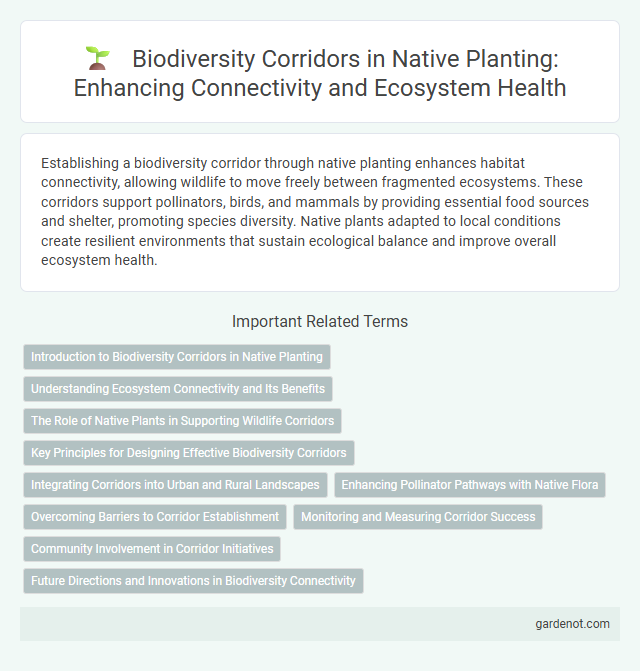Establishing a biodiversity corridor through native planting enhances habitat connectivity, allowing wildlife to move freely between fragmented ecosystems. These corridors support pollinators, birds, and mammals by providing essential food sources and shelter, promoting species diversity. Native plants adapted to local conditions create resilient environments that sustain ecological balance and improve overall ecosystem health.
Introduction to Biodiversity Corridors in Native Planting
Biodiversity corridors in native planting create vital pathways that connect fragmented habitats, enabling wildlife movement and gene flow essential for ecosystem resilience. These corridors support diverse species by incorporating indigenous plants adapted to local climates, promoting natural regeneration and habitat complexity. Enhancing landscape connectivity through native vegetation ensures sustainable biodiversity conservation and strengthens ecological networks.
Understanding Ecosystem Connectivity and Its Benefits
Biodiversity corridors enhance ecosystem connectivity by linking fragmented habitats, allowing native species to migrate, reproduce, and access resources essential for survival. These corridors support genetic diversity, reduce the risk of local extinctions, and improve resilience to environmental changes. Implementing native planting within biodiversity corridors replenishes native flora, fosters habitat complexity, and sustains ecological processes vital for long-term biodiversity conservation.
The Role of Native Plants in Supporting Wildlife Corridors
Native plants provide essential habitat and food resources within biodiversity corridors, promoting the movement and survival of wildlife species. Their deep root systems improve soil health and water retention, creating stable environments that facilitate animal passage. By supporting pollinators and prey species, native vegetation strengthens ecosystem connectivity and resilience in fragmented landscapes.
Key Principles for Designing Effective Biodiversity Corridors
Effective biodiversity corridors incorporate native planting to enhance habitat connectivity, support species migration, and preserve genetic diversity. Key principles emphasize selecting indigenous plant species that reflect local ecosystem characteristics, ensuring structural diversity to accommodate various wildlife needs. Incorporating continuous green pathways and minimizing fragmentation optimize ecological functions and resilience in these corridors.
Integrating Corridors into Urban and Rural Landscapes
Integrating biodiversity corridors into urban and rural landscapes enhances habitat connectivity, supporting native plant species and local wildlife populations. These corridors mitigate fragmentation effects by linking isolated green spaces and promoting ecological resilience. Strategic planning involves selecting native plants adapted to local conditions, ensuring corridors function as effective ecological pathways.
Enhancing Pollinator Pathways with Native Flora
Biodiversity corridors fortified with native flora significantly boost pollinator pathways by providing essential resources such as nectar, pollen, and habitat for diverse pollinator species including bees, butterflies, and moths. Incorporating indigenous plants like milkweed, goldenrod, and wild asters enhances ecosystem connectivity, promoting genetic diversity and resilience among pollinator populations. Targeted native planting supports vital pollinator life cycles and sustains agricultural productivity through improved pollination services.
Overcoming Barriers to Corridor Establishment
Establishing biodiversity corridors involves overcoming barriers such as habitat fragmentation, land-use conflicts, and invasive species encroachment. Strategies include restoring native plant communities, securing land through conservation easements, and engaging local stakeholders for collaborative management. Effective corridor design prioritizes connectivity and resilience to support native wildlife movement and genetic exchange.
Monitoring and Measuring Corridor Success
Monitoring biodiversity corridors involves tracking species diversity, population dynamics, and habitat connectivity using remote sensing and field surveys. Measuring corridor success requires analyzing data on native plant regeneration, wildlife movement patterns, and ecological condition indicators over time. Effective assessment supports adaptive management to enhance habitat restoration and maintain ecosystem resilience.
Community Involvement in Corridor Initiatives
Community involvement in biodiversity corridor initiatives strengthens ecosystem connectivity by fostering local stewardship and knowledge sharing. Engaging residents through native planting workshops and volunteer restoration projects enhances habitat quality for endangered species and pollinators. Collaborative efforts between municipalities, conservation groups, and indigenous communities accelerate corridor establishment and long-term ecological resilience.
Future Directions and Innovations in Biodiversity Connectivity
Innovations in biodiversity connectivity emphasize creating extensive native planting corridors that facilitate species migration and genetic exchange across fragmented landscapes. Future directions prioritize integrating advanced GIS mapping and drone technology to monitor habitat health and optimize corridor placement for maximum ecological impact. Enhanced native plant selection tailored to local ecosystems supports resilient habitats, promoting long-term biodiversity conservation and climate adaptation.
Biodiversity corridor Infographic

 gardenot.com
gardenot.com